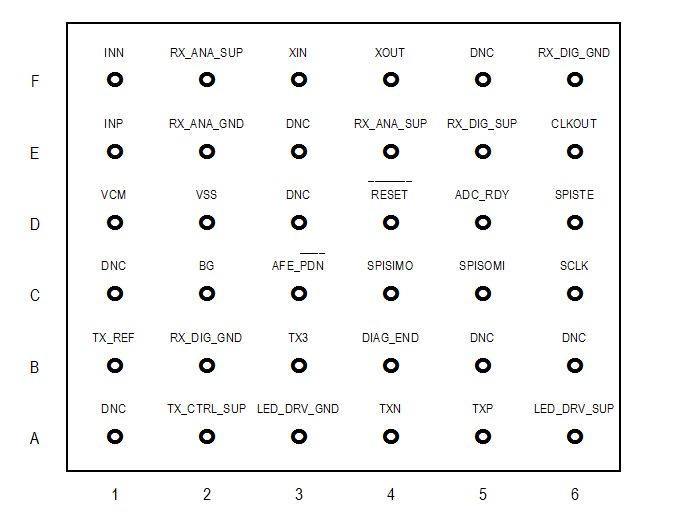SBAS650C May 2014 – April 2021 AFE4403
PRODUCTION DATA
- 1 Features
- 2 Applications
- 3 Description
- 4 Revision History
- 5 Device Family Options
- 6 Pin Configuration and Functions
- 7 Specifications
- 8 Detailed Description
- 9 Application Information Disclaimer
- 10Power Supply Recommendations
- 11Layout
- 12Device and Documentation Support
- 13Mechanical, Packaging, and Orderable Information
Package Options
Mechanical Data (Package|Pins)
- YZP|36
Thermal pad, mechanical data (Package|Pins)
Orderable Information
6 Pin Configuration and Functions
 Figure 6-1 YZP Package,DSBGA-36,(Bottom View)
Figure 6-1 YZP Package,DSBGA-36,(Bottom View)Table 6-1 Pin Functions
| PIN | FUNCTION | DESCRIPTION | |
|---|---|---|---|
| NAME | NO. | ||
| ADC_RDY | D5 | Digital | Output signal that
indicates ADC conversion completion. Can be connected to the interrupt input pin of an external microcontroller. |
| AFE_ PDN | C3 | Digital | AFE-only power-down
input; active low. Can be connected to the port pin of an external microcontroller. |
| BG | C2 | Reference | Decoupling capacitor for
internal band-gap voltage to ground. Connect a decoupling capacitor to ground. To achieve the lowest transmitter noise, use a capacitor value of 2.2 µF. To reduce the recovery time from power-down (from 1 s to 0.1 s), use a capacitor value of 0.1 µF instead—but with slightly degraded transmitter noise. |
| CLKOUT | E6 | Digital | Buffered 4-MHz output
clock output. Can be connected to the clock input pin of an external microcontroller. |
| DIAG_END | B4 | Digital | Output signal that
indicates completion of diagnostics. Can be connected to the port pin of an external microcontroller. |
| DNC(1) | C1, A1, E3, D3, F5, B5, B6 | — | Do not connect these pins. Leave as open circuit. |
| INN | F1 | Analog | Receiver input pin. Connect to photodiode anode. |
| INP | E1 | Analog | Receiver input pin. Connect to photodiode cathode. |
| LED_DRV_GND | A3 | Supply | LED driver ground pin, H-bridge. Connect to common board ground. |
| LED_DRV_SUP | A6 | Supply | LED driver supply pin, H-bridge. Connect to an external power supply capable of supplying the large LED current, which is drawn by this supply pin. |
| RESET | D4 | Digital | AFE-only reset input,
active low. Can be connected to the port pin of an external microcontroller |
| RX_ANA_GND | E2 | Supply | Rx analog ground pin. Connect to common board ground. |
| RX_ANA_SUP | F2, E4 | Supply | Rx analog supply pin; 0.1-µF decoupling capacitor to ground |
| RX_DIG_GND | B2, F6 | Supply | Rx digital ground pin. Connect to common board ground. |
| RX_DIG_SUP | E5 | Supply | Rx digital supply pin; 0.1-µF decoupling capacitor to ground |
| SCLK | C6 | SPI | SPI clock pin |
| SPISIMO | C4 | SPI | SPI serial in master out |
| SPISOMI | C5 | SPI | SPI serial out master in |
| SPISTE | D6 | SPI | SPI serial interface enable |
| TX_CTRL_SUP | A2 | Supply | Transmit control supply pin (0.1-µF decoupling capacitor to ground) |
| TX_REF | B1 | Reference | Transmitter reference
voltage, 0.25 V default after reset. Connect a decoupling capacitor to ground. To achieve the lowest transmitter noise, use a capacitor value of 2.2 µF. To reduce the recovery time from power-down (from 1 s to 0.1 s), use a capacitor value of 0.1 µF instead—but with slightly degraded transmitter noise. |
| TXN | A4 | Analog | LED driver out. Connect to LED in common anode or H-bridge configuration. |
| TXP | A5 | Analog | LED driver out. Connect to LED in common anode or H-bridge configuration. |
| TX3 | B3 | Analog | LED driver out for third LED. Connect to optional third LED supported in common anode configuration. |
| VCM | D1 | Reference | Input common-mode voltage
output. This signal can be used to shield (guard) the INP, INN traces. If used as a shield, then connect a series resistor (1 kΩ) and a decoupling capacitor (10 nF) to ground. If VCM is not used externally, then these external components are not required. |
| VSS | D2 | Supply | Substrate ground. Connect to common board ground. |
| XOUT | F4 | Digital | Crystal oscillator pins.
Connect an external crystal between these pins with the correct load capacitor (as specified by vendor) to ground. |
| XIN | F3 | Digital | Crystal oscillator
pins. Connect an external crystal between these pins with the correct load capacitor (as specified by vendor) to ground. |
(1) Leave pins as open circuit. Do not connect.